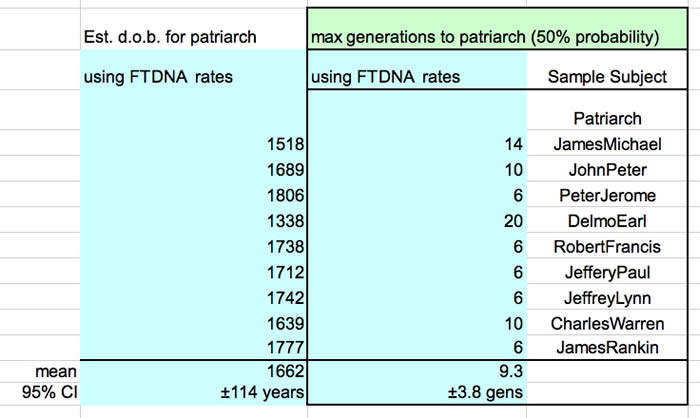Estimated d.o.b. for the patriarch of Group I
We dropped individuals who are obviously recently tied to others. To have retained them would have biased the results by giving weight to their common genetic divergence (or lack thereof). Some examples:
-- We dropped Ira Lee & Lawrence Victor, but retained James Michael.
-- We dropped Ronald Pendl, but retained Peter Jerome.
-- We dropped Anon-1 but retained Charles Warren.
Next, We decided we wanted to have some balance between numbers of individuals retained on the left-hand side of our tree, versus numbers of individuals retained on the right-hand side. Why? We didn't want to use all the putative descendents of James (b. c1718), or it would skew the results since we have so many more participants from that side. Thus, we dropped Phil, John Lynn, William Cofer, Ralph, and Claude -- and retained Jeffery Paul, Jeffrey Lynn, James Rankin, and Robert Francis. We wanted only four (to balance with the left-hand side), and we tended to choose to drop those that had CDY-marker changes because they have high-probability of change and are unreliable.
Thus, we included four from the putative James of SC line and four from the putative William of NC line. But we included only Charles Warren from the putative John of PA line. [At the time we performed this analysis, we did not have more participants allegedly from that line.]
In the end, we did the calculations with as unbiased a sampling of participants as we could assemble -- the nine shown.
Using the nine, we estimated the number of generations of each from the patriarch (at the 50% probability level -- i.e., there is a 50% chance that the patriarch is within that many generations ago). We made these calculations using FTDNA's assumed rates with the infinite allele model.
The mean distance, with 95% confidence interval, was 9.3 generations ± 3.8 generations
For each included participant, we then looked at his tree and went back as far as we could to see the d.o.b of his most ancient, listed ancestor. If we needed to go back still further, we assumed 30 years per generation to arrive at a d.o.b estimate for the patriarch from that individual's YDNA data.
Example: Using James Michael's YDNA results, the FTDNA model says that there is a 50% chance that the patriarch is within the past 14 of his generations. He can only trace back 4 generations (to Elijah b.1818). For the previous 10 generations, we assumed 30 years/gen -- therefore subtracting 300 years from 1818 to record 1518 as patriarch's d.o.b.
After doing this for each of the nine, we then computed the mean d.o.b and 95% CI for it.
Using the FTDNA mutation model -- and assuming these nine participants are a good sample -- gives a patriarch's d.o.b. of 1662 ± 114 years. Or a date range from 1548 to 1776.
